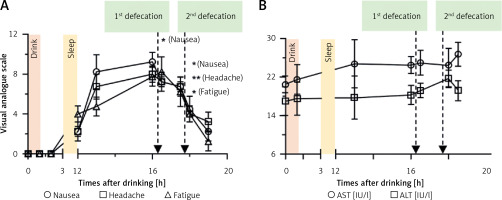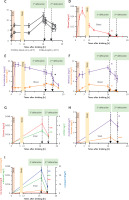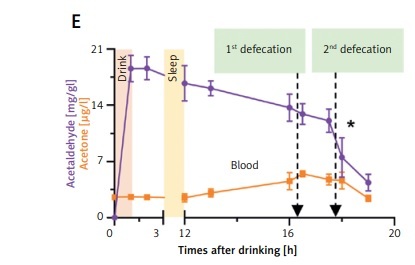Hangover, a condition experienced after binge drinking, is caused by various alcohol metabolites, such as acetaldehyde, in the bloodstream. Common hangover symptoms, such as nausea, headache, and fatigue, can significantly reduce work efficiency. Following ethanol binge drinking, acetaldehyde undergoes conversion to acetate and subsequently forms acetyl-CoA. Acetyl-CoA can then be further metabolized into acetone and iso-propanol [1]. Moreover, it is important to note that methanol is naturally present in everyday foods like pectin. When excessive ethanol consumption saturates CYP2E1, methanol cannot be efficiently metabolized, resulting in an increase in methanol levels in the blood [2].
Although a substantial portion of the population experiences hangovers, there is currently no definitive cure available [3–5]. Folk remedies in many cultures suggest that defecation can alleviate hangover symptoms. However, the effect of defecation on hangovers has not been adequately explored. Investigating the effect of defecation might provide important clues for symptomatic relief from hangovers.
Methods
This pilot study was approved by the Institutional Review Board of Yonsei University Wonju College of Medicine (IRB No. CR321086). Four healthy male volunteers (age, 30–34 years old; weight, 71–79 kg; no history of liver disease) participated in a two-week period of alcohol abstinence. Baseline venous blood and stool samples were collected from each participant. A standardized sandwich diet with an equal amount of water was provided to all participants. The participants were subsequently administered 2.5 g/kg of ethanol by consuming commercially available vodka (Absolut®, 40% Alc./Vol., V&S Vin & Sprit AB., Sweden). At multiple timepoints, the severity of hangover symptoms was assessed using a visual analogue scale. Blood samples were obtained for complete blood count analysis (ADVIA®, Siemens Healthineers, Germany), serum chemistry (Atellica®, Siemens Healthineers, Germany). A range of hangover symptoms, liver enzymes were statistically analyzed using GraphPad Prism v8.0 (GraphPad Software). Data in the graph are presented as means ± SEM. Statistical comparison of the values in the graph was conducted by unpaired Student’s t test and the specific comparison was done between the prior time point and the present time point.
The blood samples were also analyzed to investigate various alcohol species and metabolites by gas chromatography (Agilent Technologies, Santa Clara, CA). On the following morning, the first and second feces were also collected for gas chromatography. The fecal samples were homogenized with a blender and concentrations of ethanol, acetaldehyde, acetone, propanols, and butanols were analyzed [6]. The vodka used in the current study was also analyzed using gas chromatography to verify that it contained solely ethanol, without any other alcohol species such as methanol.
Results
The severity of hangover symptoms was most pronounced immediately before the first defecation. However, these symptoms were significantly relieved by both the first and second defecations (Figure 1 A). Liver enzymes remained elevated throughout the study but showed a slight decrease after the second defecation (Figure 1 B). The neutrophil count, an indicator of inflammatory response, peaked before the first defecation and gradually decreased during subsequent defecations (Figure 1 C). The blood ethanol concentration rapidly increased initially but steadily decreased and reached zero immediately after the first defecation (Figure 1 D). Acetaldehyde levels in the blood peaked following binge drinking and then gradually decreased. Consecutive defecation led to a significant reduction in blood acetaldehyde levels, whereas the levels of acetone, an acetaldehyde metabolite, increased slightly during the same period (Figure 1 E). Blood methanol and iso-propanol levels were significantly reduced by defecations (Figure 1 F). The first stool sample contained higher levels of alcohol species and acetaldehyde than the second one (Figures 1 G–I).
Figure 1
A longitudinal observation of hangover symptoms and alcohol metabolites in healthy humans following binge drinking. A – Visual analogue scales of hangover-related symptoms (nausea, headache, and fatigue). B – Blood aspartate transaminase (AST) and alanine transaminase (ALT). C – White blood cell and neutrophil counts. D – Blood ethanol levels. E – Blood acetaldehyde and acetone levels. F – Blood methanol and iso-propanol levels. G – Stool ethanol and iso-propanol levels. H – Stool acetaldehyde and acetone levels. I – Stool iso-butanol, 2-butanol, n-butanol, and n-propanol levels
*p < 0.05, **p < 0.01, ***p < 0.001.


After the first defecation, there was a rapid decline in blood ethanol concentration, indicating a shift in which the ethanol absorption rate by the intestine became slower than the metabolism rate by the liver. However, high levels of blood acetaldehyde and methanol persisted, and hangover symptoms remained severe. Under this condition, if an individual were to drive, it would not be considered drunk driving, as they would pass a breathalyzer test. However, the presence of acetaldehyde and methanol in the bloodstream would still impair their driving abilities. After the second defecation, blood acetaldehyde and methanol levels decreased, resulting in significant alleviation of hangover symptoms (Figures 1 A, D, E, F).
Discussion
Orally consumed ethanol is continuously absorbed into the bloodstream throughout the gastrointestinal tract. The absorption rate of the intestine is higher than that of the stomach, primarily because of its thinner mucosal layer and larger surface area [7]. Before defecations, ethanol in the intestinal lumen is consistently absorbed into the bloodstream. Because the intestine has a faster absorption rate than the metabolism rate of the liver, ethanol and acetaldehyde levels remain elevated. However, upon sufficient defecation, there was a substantial decrease in ethanol content within the intestinal lumen. This reduction led to a corresponding decrease in ethanol and acetaldehyde levels in the bloodstream. Consequently, the participants experienced a reduced level of intoxication and lower likelihood of experiencing hangover symptoms. This phenomenon can be referred to as “intestinal drinking”, emphasizing the continuous absorption of ethanol by the intestine until sufficient defecations.
Although the vodka used in this study solely contained ethanol, additional alcohol species were identified in the bloodstream. Daily food in the digestive tract can be metabolized to n-butanol, n-propanol, acetone, iso-propanol, ethanol, and methanol. When ethanol is not ingested, the liver rapidly metabolizes these alcohol species, leading to negligible levels in the bloodstream [8]. However, during binge drinking episodes, ingested ethanol is converted to n-butanol, acetone, and iso-propanol through the acetyl-CoA pathway, leading to increased levels of various alcohol metabolites [9]. After sufficient defecations, the absorption of ethanol significantly decreases, leading to a subsequent reduction in the levels of alcohol metabolites in the bloodstream. This decrease in alcohol metabolites has the potential to minimize the risk of liver damage.
If complete alcohol abstinence is not feasible in daily life, promoting timely bowel movements after drinking to expedite bowel transit time may offer an alternative strategy to alleviate the effects of hangovers and reduce the risk of alcohol-related liver damage [10]. This method shares a similar principle to the utilization of laxatives in individuals with hepatic encephalopathy [11]. Furthermore, the effects of defecation can be considered in the treatment of methanol intoxication [12].
Future studies with larger sample sizes of human volunteers or animal models will provide additional validation of the impact of defecation on alcohol metabolism. Additionally, dietary supplements that promote defecation may be beneficial in reducing hangover symptoms and minimizing liver damage.
This pilot study highlights the concept of “intestinal drinking” and underscores the significance of defecation in alleviating hangover symptoms and potentially reducing the risk of liver damage. Although research to find a cure for hangovers is still limited, this study examined alcohol metabolites in humans who engaged in binge drinking and experienced subsequent hangovers. In relation to the gut-liver axis, this study may represent new potential targets for the treatment of hangovers and mitigation of alcoholic liver diseases [13].



